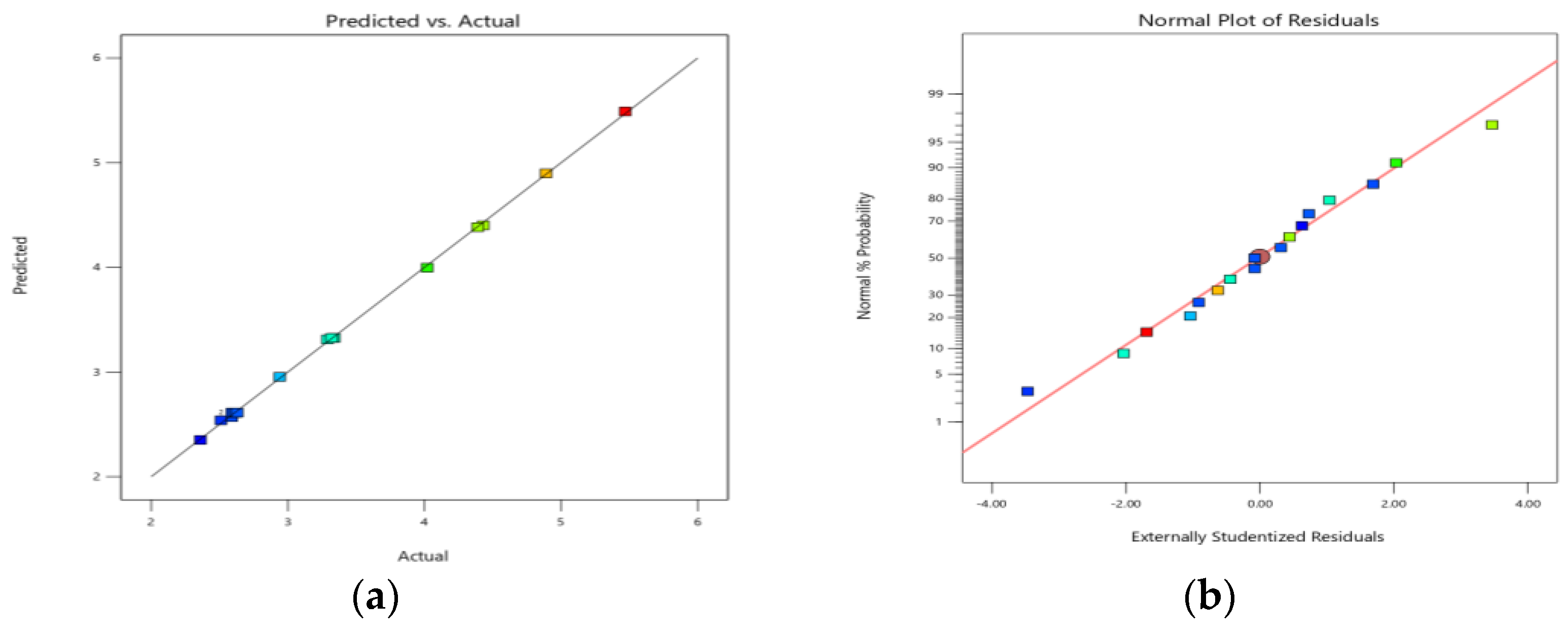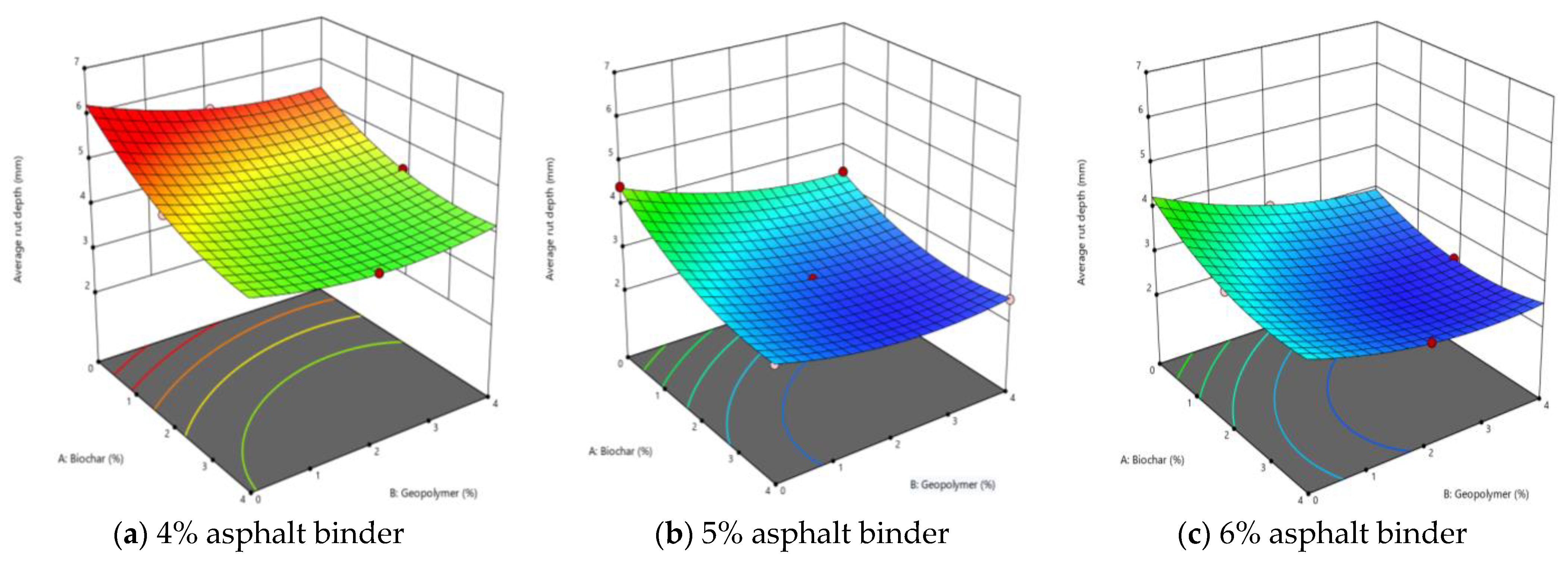Evaluating the Effect of Asphalt Binder and Bio-Geopolymer Composite on the Permanent Deformation Resistance of Asphalt Concrete via Response Surface Method †
Abstract
:1. Introduction
2. Materials and Methods
2.1. Asphalt Binder and Aggregate
2.2. Bio-Geopolymer Composite
2.3. Modified Asphalt Binder Preparation
2.4. Permanent Deformation Test
2.5. RSM Design of Experiment and Analysis
3. Results and Discussion
3.1. RSM Statistical Assessment
3.2. Design Parameters’ Optimisation
4. Conclusions
Author Contributions
Funding
Institutional Review Board Statement
Informed Consent Statement
Data Availability Statement
Acknowledgments
Conflicts of Interest
References
- Wang, L.; Xue, X.; Zhao, Z.; Wang, Z. The impacts of transportation infrastructure on sustainable development: Emerging trends and challenges. Int. J. Environ. Res. Public Health 2018, 15, 1172. [Google Scholar] [CrossRef] [PubMed]
- Du, Y.; Chen, J.; Han, Z.; Liu, W. A review on solutions for improving rutting resistance of asphalt pavement and test methods. Constr. Build. Mater. 2018, 168, 893–905. [Google Scholar] [CrossRef]
- Chen, J.; Dan, H.; Ding, Y.; Gao, Y.; Guo, M. New innovations in pavement materials and engineering: A review on pavement engineering research 2021. J. Traffic Transp. Eng. 2021, 8, 815–999. [Google Scholar] [CrossRef]
- Yaro, N.S.A.; Sutanto, M.H.; Habib, N.Z.; Usman, A.; Kaura, J.M.; Murana, A.A.; Birniwa, A.H.; Jagaba, A.H. A Comprehensive Review of Biochar Utilization for Low-Carbon Flexible Asphalt Pavements. Sustainability 2023, 15, 6729. [Google Scholar] [CrossRef]
- Al-Sabaeei, A.M.; Al-Fakih, A.; Noura, S.; Yaghoubi, E.; Alaloul, W.; Al-Mansob, R.A.; Khan, M.I.; Yaro, N.S.A. Utilization of palm oil and its by-products in bio-asphalt and bio-concrete mixtures: A review. Constr. Build. Mater. 2022, 337, 127552. [Google Scholar] [CrossRef]
- Zhao, S.; Huang, B.; Ye, X.P.; Shu, X.; Jia, X. Utilizing bio-char as a bio-modifier for asphalt cement: A sustainable application of bio-fuel by-product. Fuel 2014, 133, 52–62. [Google Scholar] [CrossRef]
- Usman, A.; Sutanto, M.H.; Napiah, M.; Zoorob, S.E.; Yaro, N.S.A.; Khan, M.I. Comparison of performance properties and prediction of regular and gamma-irradiated granular waste polyethylene terephthalate modified asphalt mixtures. Polymers 2021, 13, 2610. [Google Scholar] [CrossRef] [PubMed]
- Jagaba, A.H.; Kutty, S.R.M.; Baloo, L.; Birniwa, A.H.; Lawal, I.M.; Aliyu, M.K.; Yaro, N.S.A.; Usman, A.K. Combined treatment of domestic and pulp and paper industry wastewater in a rice straw embedded activated sludge bioreactor to achieve sustainable development goals. Case Stud. Chem. Environ. Eng. 2022, 6, 100261. [Google Scholar] [CrossRef]
- Yaro, N.S.A.; Sutanto, M.H.; Habib, N.Z.; Napiah, M.; Usman, A.; Muhammad, A. Comparison of Response Surface Methodology and Artificial Neural Network approach in predicting the performance and properties of palm oil clinker fine modified asphalt mixtures. Constr. Build. Mater. 2022, 324, 126618. [Google Scholar] [CrossRef]
- BS 598-110; Methods of Test for the Determination of Wheel-Tracking Rate and Depth, in Sampling and Examination of Bituminous Mixtures for Roads and Other Paved Areas. British Standard: London, UK, 1998.
- Ghaleb, A.A.S.; Kutty, S.R.M.; Ho, Y.-C.; Jagaba, A.H.; Noor, A.; Al-Sabaeei, A.M.; Almahbashi, N.M.Y. Response surface methodology to optimize methane production from mesophilic anaerobic co-digestion of oily-biological sludge and sugarcane bagasse. Sustainability 2020, 12, 2116. [Google Scholar] [CrossRef]
- Usman, A.; Sutanto, M.H.; Napiah, M.B.; Yaro, N.S.A. Response surface methodology optimization in asphalt mixtures: A review. In Response Surface Methodology in Engineering Science; IntechOpen: London, UK, 2021. [Google Scholar]


| Sieve Size (mm) | 20 | 14 | 10 | 5 | 3.35 | 1.18 | 0.425 | 0.15 | 0.075 |
| PWD Limit (%) | 100 | 90–100 | 76–86 | 50–62 | 40–54 | 18–34 | 12–24 | 6–14 | 4–8 |
| Study Sample (%) | 100 | 95 | 81 | 56 | 47 | 26 | 18 | 10 | 6 |
| Run No. | Input Variables | Response | ||
|---|---|---|---|---|
| Biochar | Geopolymer | Asphalt Binder | ARD (mm) | |
| 1 | 4 | 2 | 6 | 2.59 |
| 2 | 0 | 4 | 5 | 3.34 |
| 3 | 0 | 2 | 6 | 3.29 |
| 4 | 2 | 0 | 4 | 4.89 |
| 5 | 2 | 2 | 5 | 2.59 |
| 6 | 2 | 4 | 6 | 2.36 |
| 7 | 2 | 4 | 4 | 4.39 |
| 8 | 2 | 2 | 5 | 2.62 |
| 9 | 4 | 2 | 4 | 4.02 |
| 10 | 0 | 0 | 5 | 4.43 |
| 11 | 2 | 2 | 5 | 2.61 |
| 12 | 0 | 2 | 4 | 5.47 |
| 13 | 2 | 0 | 6 | 3.32 |
| 14 | 4 | 0 | 5 | 2.94 |
| 15 | 2 | 2 | 5 | 2.63 |
| 16 | 2 | 2 | 5 | 2.61 |
| 17 | 4 | 4 | 5 | 2.51 |
| Variable | SS | DF | MS | F-Value | p-Value | Observation |
|---|---|---|---|---|---|---|
| Type of model | Quadratic | |||||
| Model | 14.71 | 9 | 1.63 | 2309.20 | <0.0001 | Significant |
| A-Biochar | 2.50 | 1 | 2.50 | 3528.41 | <0.0001 | |
| B-Geopolymer | 1.11 | 1 | 1.11 | 1568.18 | <0.0001 | |
| C-Asphalt binder | 6.50 | 1 | 6.50 | 9179.84 | <0.0001 | |
| AB | 0.1089 | 1 | 0.1089 | 153.84 | <0.0001 | |
| AC | 0.1406 | 1 | 0.1406 | 198.66 | <0.0001 | |
| BC | 0.0529 | 1 | 0.0529 | 74.73 | <0.0001 | |
| A² | 0.6661 | 1 | 0.6661 | 941.05 | <0.0001 | |
| B² | 0.3670 | 1 | 0.3670 | 518.53 | <0.0001 | |
| C² | 2.92 | 1 | 2.92 | 4124.96 | <0.0001 | |
| Residual | 0.0050 | 7 | 0.0007 | |||
| Lack of Fit | 0.0041 | 3 | 0.0014 | 6.17 | 0.0555 | Not significant |
| Pure Error | 0.0009 | 4 | 0.0002 | |||
| Cor Total | 14.72 | 16 | ||||
| Fit Statistics | ||||||
| 0.997 | Standard deviation | 0.0266 | ||||
| 0.992 | Mean | 3.33 | ||||
| 0.995 | Adequate precision | 153.8 | ||||
| Input Variable | % Content | ARD Values (mm) | % Error | |
|---|---|---|---|---|
| RSM Predicted | Experimental | |||
| Biochar | 3.22 | 2.27 | 2.36 | 3.96 |
| Geopolymer | 1.81 | |||
| Asphalt content | 5.4 | |||
Disclaimer/Publisher’s Note: The statements, opinions and data contained in all publications are solely those of the individual author(s) and contributor(s) and not of MDPI and/or the editor(s). MDPI and/or the editor(s) disclaim responsibility for any injury to people or property resulting from any ideas, methods, instructions or products referred to in the content. |
© 2023 by the authors. Licensee MDPI, Basel, Switzerland. This article is an open access article distributed under the terms and conditions of the Creative Commons Attribution (CC BY) license (https://creativecommons.org/licenses/by/4.0/).
Share and Cite
Yaro, N.S.A.; Sutanto, M.H.; Baloo, L.; Habib, N.Z.; Usman, A.; Muhammad, A.B.; Jagaba, A.H. Evaluating the Effect of Asphalt Binder and Bio-Geopolymer Composite on the Permanent Deformation Resistance of Asphalt Concrete via Response Surface Method. Eng. Proc. 2023, 56, 311. https://doi.org/10.3390/ASEC2023-15560
Yaro NSA, Sutanto MH, Baloo L, Habib NZ, Usman A, Muhammad AB, Jagaba AH. Evaluating the Effect of Asphalt Binder and Bio-Geopolymer Composite on the Permanent Deformation Resistance of Asphalt Concrete via Response Surface Method. Engineering Proceedings. 2023; 56(1):311. https://doi.org/10.3390/ASEC2023-15560
Chicago/Turabian StyleYaro, Nura Shehu Aliyu, Muslich Hartadi Sutanto, Lavania Baloo, Noor Zainab Habib, Aliyu Usman, Abubakar Baffa Muhammad, and Ahmad Hussaini Jagaba. 2023. "Evaluating the Effect of Asphalt Binder and Bio-Geopolymer Composite on the Permanent Deformation Resistance of Asphalt Concrete via Response Surface Method" Engineering Proceedings 56, no. 1: 311. https://doi.org/10.3390/ASEC2023-15560






